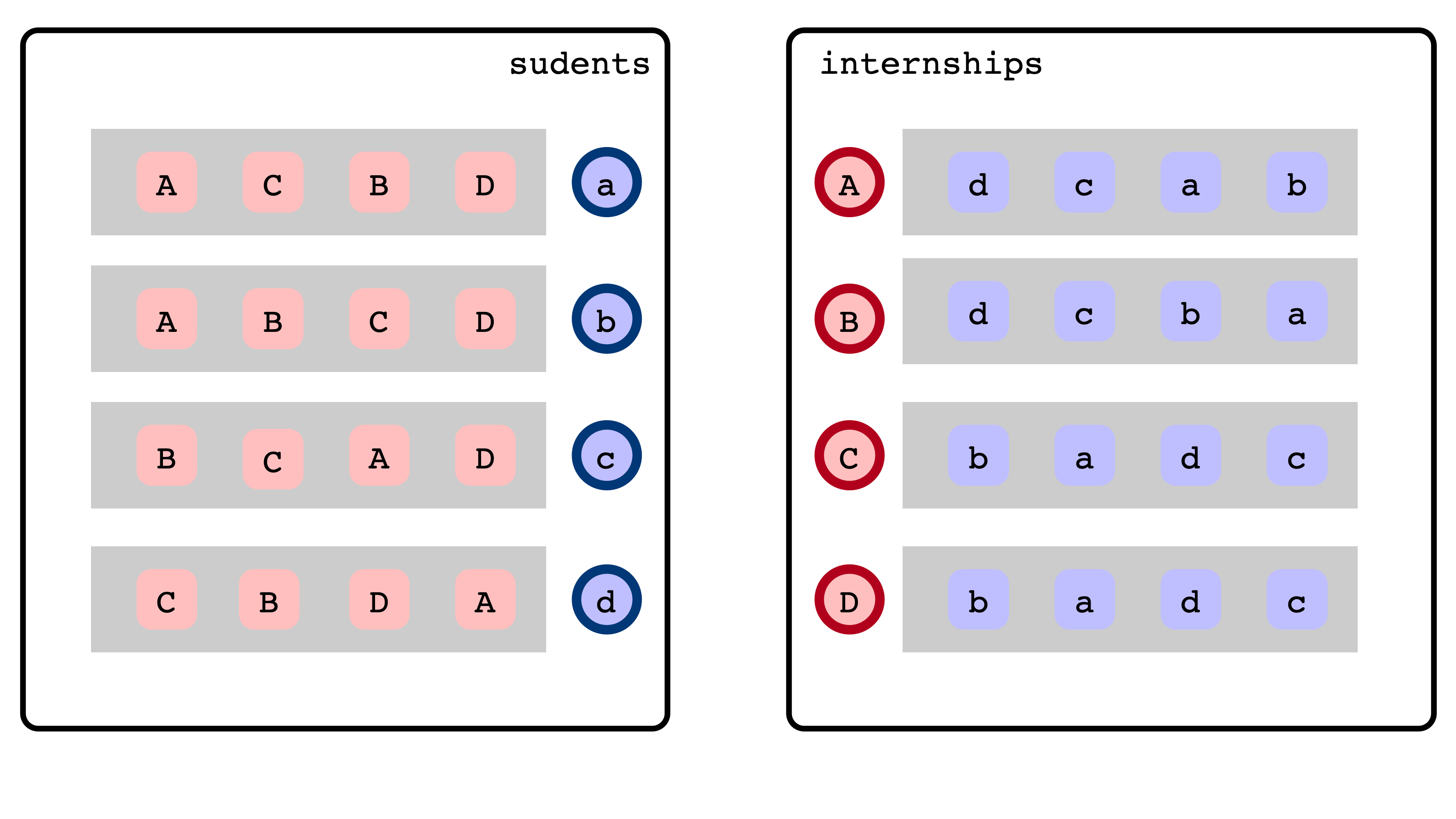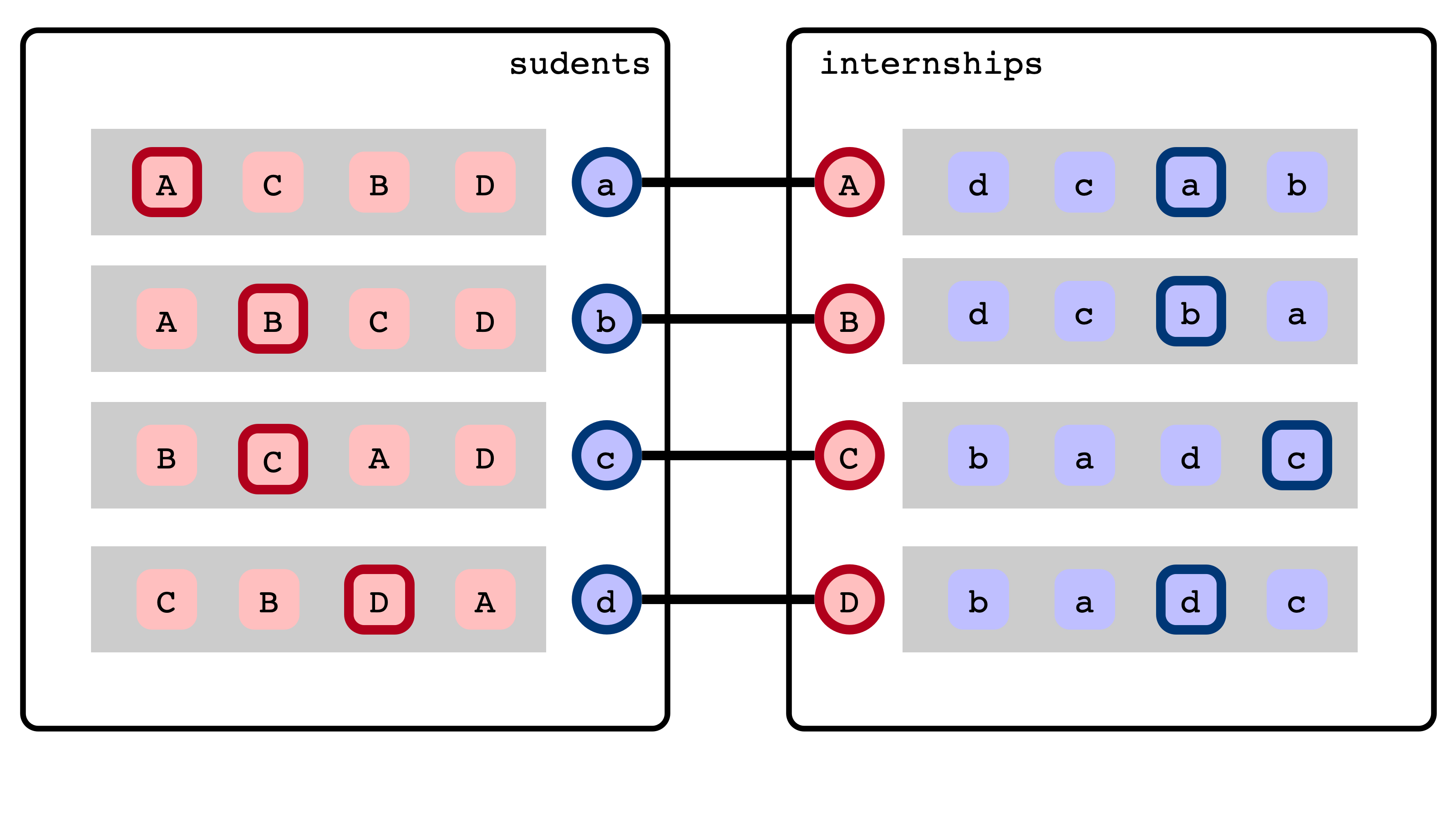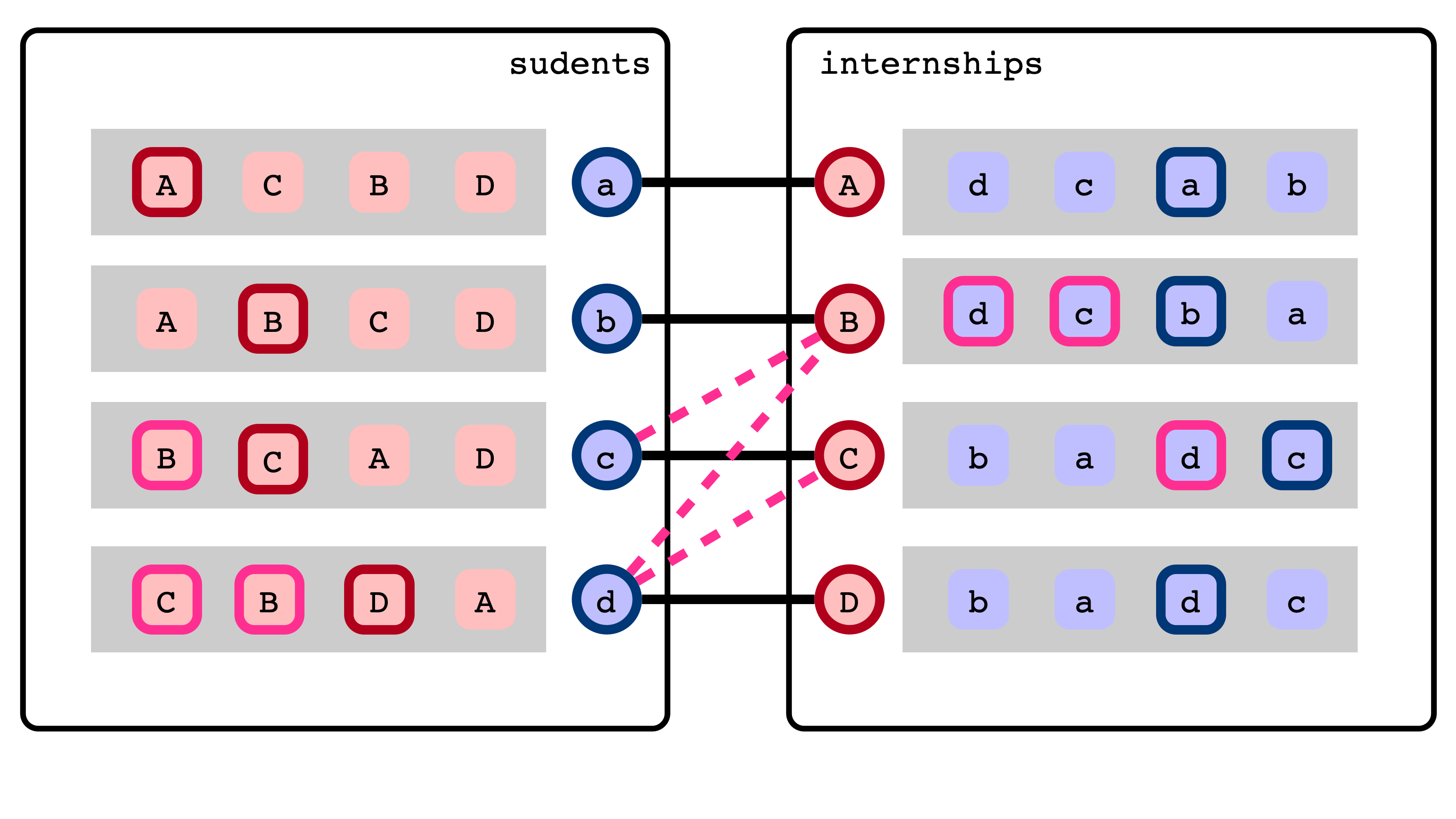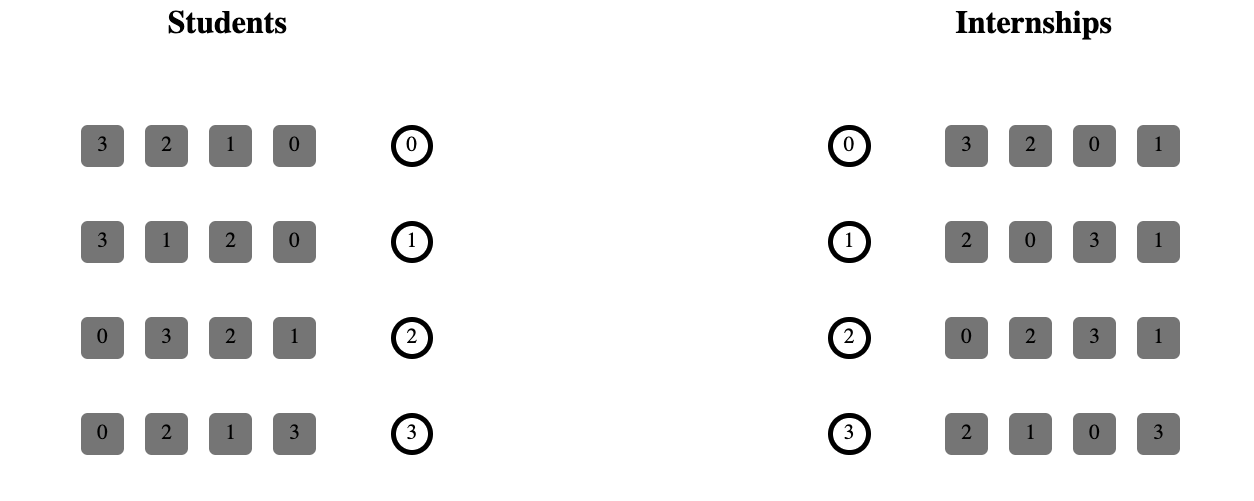Lecture 23: Stable Matchings
COSC 225 Algorithms and Visualization, Spring 2023
Announcements
Reminders:
- Final project submissions due Wednesday, 5/10 by 5:00pm
- After final project submissions, peer review during finals week
- due Friday, 5/19 by 5:00pm
Class Next Monday (05/08)
- no lecture
- workshop/OH
- Oren and I will have last-minute help
Overview
- Stable Marriage Problem
- Gale-Shapley Algorithm
- Gale-Shapley Demo
- Different Perspectives
- my research
Internship Assignment Problem
In a small world…
- Four students: $a, b, c, d$
- Four internships: $A, B, C, D$
Question. How should we assign students to internships?
Preferences
Agents have preferences in the form of a strict ranking of alternatives
- each student ranks available internships
- each internship ranks available students

Question
How do we decide whether a matching “respects” agents’ preferences?

Blocking Pairs and Stability
Given:
- students, internships, preferences
- matching $M$
We say $(s, t)$ is a blocking pair if
- $s$ and $t$ are not matched with each other
- $s$ prefers $t$ to assigned internship in $M$
- $t$ prefers $s$ to assigned student in $M$
Blocking Pair Illustration

Blocking Pair Illustration

Stable Marriage Problem
Gale-Shapley 1962
Input:
- set of $n$ students
- set of $n$ interships
- for each student $s$, preference list ranking all internships
- for each internship $t$, preference list ranking all students
Output:
- a matching $M$ between students and internships
- $M$ is stable
- there are no blocking pairs
Questions
- Do stable matchings always exist?
- are there sets of preference lists for which there is no stable matching?
- How can we find a stable matching (if one does exist)?
Answer
Theorem (Gale-Shapley 1962). Yes! Stable matchings always exist, and there is an efficient algorithm to find one.
Gale-Shapley, Illustrated
lec23-stable-matchings.zip
Gale-Shapley Pseudocode
- initially, all students/internships unmatched
- while some student is unmatched
- for each unmatched student $s$,
- $s$ applies to next favorite internship
- for each internship $t$
- $t$ defers best applicant so far, rejects others
- rejected students unmatch
- for each unmatched student $s$,
Observations
- Students apply sequentially in decreasing order of preference
- $s$ only applies to $t$ after $s$ has been rejected by all preferred internships
- For each internship, deferred candidates are increasingly preferred
- Once an internship receives an application, it stays matched
Termination
Claim 1. Gale-Shapley terminates after at most $n (n - 1) + 1$ applications.
Stability
Claim 2. When Gale-Shapley terminates, the resulting matching is stable.
Conclusion
Theorem (Gale-Shapley, 1962). Every instance of the stable marriage problem admits a stable matching. If there are $n$ students and internships, a stable matching can be found in $O(n^2)$ time.
Influence and Applications
- Introduced stability as key concept in economics
- 8,000+ papers spanning econ/cs/math
- 2012 Nobel Prize in economics (Roth and Shapley)
- stable allocations and mechanism design
- Applications:
-
matching med students with residencies
- content delivery networks
- kidney exchanges (variant)
-
Influence on My Research
Stable matchings in a decentralized setting
- Each agent is own computational entity
- Agents must communicate in order to find a matching
Question 1
Is it reasonable to assume all agents explicitly know their own preferences?
Other Mechanisms
Do not assume preferences are explicitly known:
- match-maker interacts with agents by performing queries
- a query is simply a yes/no (Boolean) function about preferences
- e.g., “Would you prefer to work for a large company, or a small company?”
- match maker performs queries until enough information about preferences is elicited to determine a stable matching
- like “20 Questions”
Note. Gale-Shapley can be implemented with $O(n^2 \log n)$ queries.
A Result
Theorem (Gonczarowski, Nisan, Ostrovsky, R–). Any mechanism that finds or verifies a stable matching uses $\Omega(n^2)$ queries in the worst case.
- finding/verifying stable matchings reveals a significant amount of information about preferences
- running time of Gale-Shapley is optimal, up to $\log n$ factor
Further Implications
Finding “almost stable” matchings also requires $\Omega(n^2)$ queries.
-
“early binding commitments” either lead to
- instability
- unraveling
Implementation Notes
Structure
-
Agentclass for a student/internship- has id, type, preference lists and current match
- compare proposals and reject
-
AgentVisualizerstores DOM elements to represent anAgent -
SMInstance- collections of students and internships
- generates random preferences, handles proposals/rejections
-
MatchingViewerkeeps track of lines -
GaleShapleysteps through proposal/rejection rounds
JavaScript Variable Assignment
What is wrong with this method?
this.receiveProposal = function (agentID) {
if (!this.prefList.includes(agentID)) return agentID;
if (this.curMatch == null) {
this.curMatch = agentID;
return null;
}
if (this.prefers(agentID, this.curMatch)) {
let rejected = this.curMatch;
curMatch = agentID;
return rejected;
}
return agentID;}
Not Equivalent?
let a = 4a = 4var a = 4
Dammit, JavaScript!
SomeClass = function () {
this.a = 4;
this.foo = function () {
a = 5;
...
a = 6;
}
}
Drawing Preference Lists
The Setup. AgentVisualizer stores this.prefElts, an array of DOM elements

The Goal
Draw the elements in preference rank order
- should be easily modifiable (if prefs change)
- use a
flexboxto handle the actual drawing

A Tool
You can associate data with DOM elements
- think a variable/value associated to each element
In JS, this can be done by setting the dataset attribute:
const pref = document.createElement("div");
pref.classList.add("pref-item");
pref.innerText = '' + id;
pref.dataset.rank = this.agent.prefList.indexOf(id);
pref.dataset.id = id;
this.prefs.appendChild(pref);
this.prefElts.push(pref);
Sorting DOM Elements by Rank
this.sortPreferenceElements = function () {
for (let pe of this.prefElts) {
pe.dataset.rank = this.agent.prefList
.indexOf(Number(pe.dataset.id));
}
this.prefElts.sort((a, b) => a.dataset.rank - b.dataset.rank);
for (let elt of this.prefElts) {
this.prefs.appendChild(elt);
}}
To-Do Items
- Click to add agents
- Button to randomize preferences, intialize instance
- Interactively modify preferences
- drag to re-order preference list